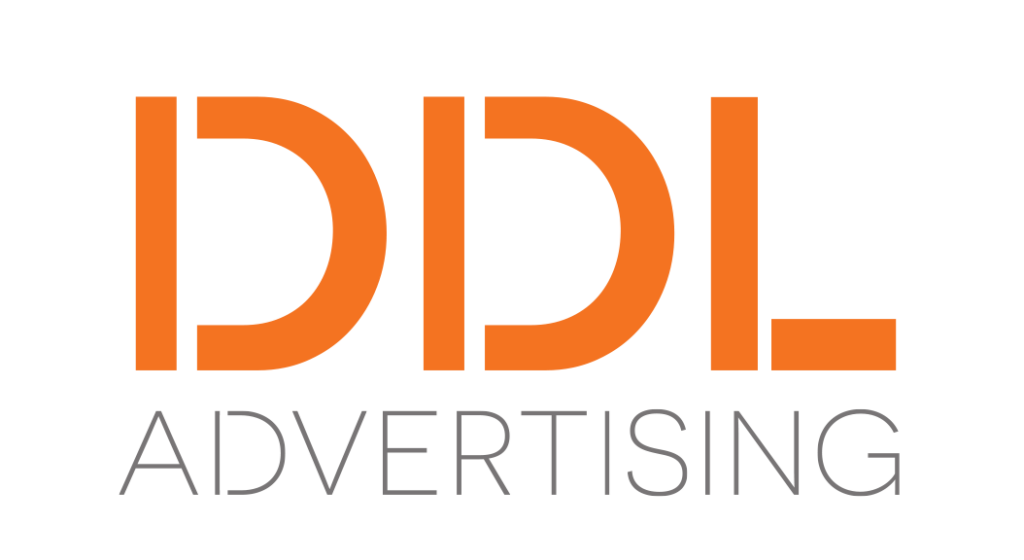
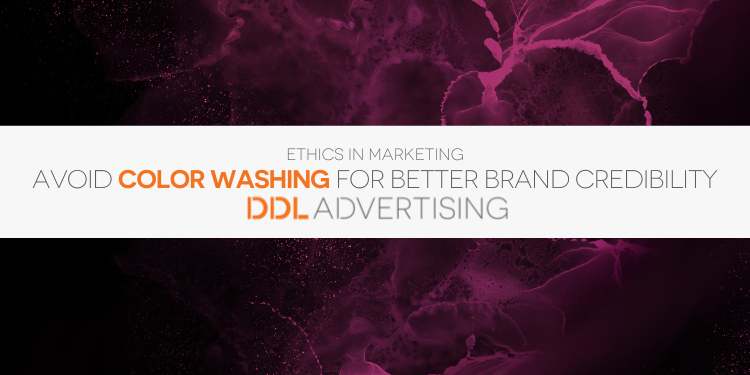
Overview.
If you’ve ever scrolled the internet (if you haven’t, you’re a liar, and I don’t trust you), you’ve likely seen some ad with a value prop, something like 50% of proceeds go to XYZ charity, cause, or fund.
“Oh wow, what a great cause,” or “How great of that company to support that cause, I’ll give them business,” you might have thought. We hope the company will follow through with that promise, but this could be an ethically questionable practice we’re going to broadly call ‘color washing.’
Color washing (here including rainbow, green, and brown) refers to the practices of leaning into partial exploitation of certain groups or causes to make a profit. We’ve been talking about ethics this month, and we’re going to jump into each of these “colors” to talk about who or what might be at risk, how not to fall victim to these traps, and why these tactics are damaging your brand and your credibility.
What is Rainbow Washing?
June is widely accepted as Pride Month for the LGBTQIA2S+ community (Queer from here on out because it’s easier than putting in the alphabet mafia every time). It’s a time to reflect on queer history, propel queer voices, and buy anything with a rainbow on it, right? Not so fast, Mary.
During Pride Month, brands and businesses “show their support” by launching Pride merch, donating to the Trevor Project, and, most notably, changing their LinkedIn profile photos to a rainbow version of their logo. Some are more aligned with the current iteration of the Pride flag than others (indicative of thorough attention to the matter, obviously).
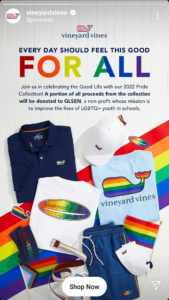
More often than not, this will be the extent of the conversion between brands and their consumers: a quick “merch drop” of rainbow sneakers or whatever Target is pandering to promote “inclusivity” while using co-opted slang to encourage people to “sashay into deals.” All of this is done with little follow-up after June 30th. But these brands aren’t stupid; they are doing the financially savvy thing: Leaning into a trend to turn a profit.
Yes, they may say a portion of proceeds benefit a charity, but would consumers have purchased the product if it wasn’t Pride-themed? The concept of color washing functions a lot like the “pink tax,” the idea that women’s products, specifically health and beauty products, are somehow more important and should cost more.
At its core, color washing leverages humanity’s capacity for philanthropy, promising commitment to causes, but just enough to satisfy short attention spans.
Nothing better describes this than this meme, a staple in the queer community. As soon as the trend is over, brands recede to their ethically questionable corners, touting the profits generated under the guides of equality. Now this isn’t to say some brands aren’t doing Pride right; the commitment to queer people and all the other people and causes mentioned in this blog is something brands must be working on year-round, not only when it’s in vogue.
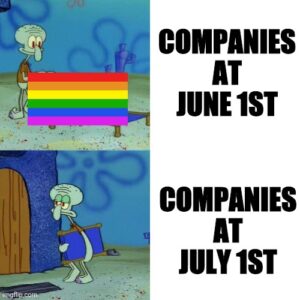
To avoid backlash this pride season, here are some recommendations on how to navigate Pride month and all the festivities:
- Talk to your queer employees – instead of trying to “think like a queer person,” ask one. This could give your campaign valuable insight.
- Be prepared to commit – If you’re going to support a cause, again consult your queer team members, but be ready to do more for the cause beyond June. Only celebrating or doing the work when it’s trendy isn’t activism; it’s a money grab. Younger demographics can see that and will adjust their support accordingly.
- When in doubt, don’t – If you don’t want to be part of the conversation, respectfully abstain. Not everyone needs to be a part of the conversation if it’s not relevant to your brand or you don’t have queer folks on staff.
- Reflect internally in lieu of sales or promotion – Take the month to learn about queer history and how it may impact your business.
- Support queer businesses – Maybe you do lunch and learn catered from a queer-owned business or solicit some team-building activities from a queer establishment. – These can all be opportunities to post about socially as long as you are committed to learning outside of June (otherwise, it’s rainbow washing).
What Is Greenwashing?
Greenwashing is similar to rainbow washing but more dastardly to the planet. Unlike Pride, there is no specific “planet month.” Yes, we have Earth Day, but greenwashing is ever-present and increasingly difficult to spot.
Greenwashing is a tactic brands employ to make it “seem” like their products are organic and environmentally friendly or promote sustainable production and consumption. These are difficult to spot as consumers typically aren’t aware of the entire life cycle of a product and the impact its creation has on our environment.
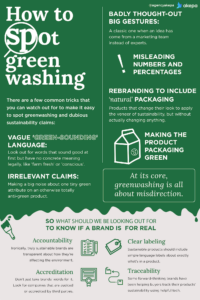
Thanks to Akepa for this great guide on how to spot greenwashing
The fashion industry is a culprit of greenwashing. Brands may tout donating proceeds (again, profit they might not have made if not for the initiative) to plant trees or commit to carbon neutrality but conveniently leave out textile production’s increased stress on the environment. From dye in water supplies to the increasing reliance on petroleum and plastic in our clothes (polyester, spandex, nylon, and other synthetic fibers all derive from oil), Brands will lead you to believe that they are invested in the preservation of the earth, while simultaneously contributing to the problem.
Millennials and Gen Z are the most conscious about Greenwashing because they stand to be most directly affected by climate change. They are also the most transparent generations with their dollars to avoid greenwashing. They expect to see full transparency in producing products and goods and will reward brands that act responsibly with their dollars. 87% of millennials are willing to pay more to support brands authentically committed to sustainability.
Patagonia leads the way in prioritizing sustainability. They have made it a mission to promote sustainability and eliminate greenwashing tactics and have been rewarded as one of the most progressive brands on the planet.
Need help determining where you fall on the greenwashing scale? Here are questions to ask about your business:
- Do we use vendors for production that prioritize sustainability?
- What is our business’s carbon footprint?
- Are there steps we can take to minimize our impact on the planet while not sacrificing profits?
- Does our business understand how climate change will affect our customers (Ex: Black and brown people stand to be the most adversely affected by climate change).
- Are we aligned with organizations or causes that help us understand our impact?
- Are there new efficiencies we can find to minimize our carbon footprint?
To show commitment and some ethical responsibility, it could be wise for your business to look into sustainable practices, which include:
- Considering remote work (this eliminates greenhouse gasses caused by commuting).
- Turning off the lights – overhead lighting pulls a lot of energy.
- Switching to e-signature documents vs printing (if possible).
- Working on becoming a B-corp business.
- Learning from local environmental groups on how your business impacts the environment.
What Is Brownwashing?
Brownwashing deals less with sales and more with the passive activation of black and brown people. Most notably, during periods of intense conflict, companies may engage in brownwashing by tacitly appeasing the masses with a press release or some official statement but failing to put in the work to advance DEI initiatives.
Recall the spring of 2020 – a turbulent time, no doubt, for a country dealing with a racial reckoning, a paralyzing virus, and a wild presidential election. In these moments, communities nationwide demanded brands take action to support black and brown people. What was observed was a mixed bag of brands that did the work to elevate these voices and continue to do so. Others posted tiles or crafted eloquent blurbs that lasted only as long as the attention did.
One such example and study in brownwashing was New Balance.
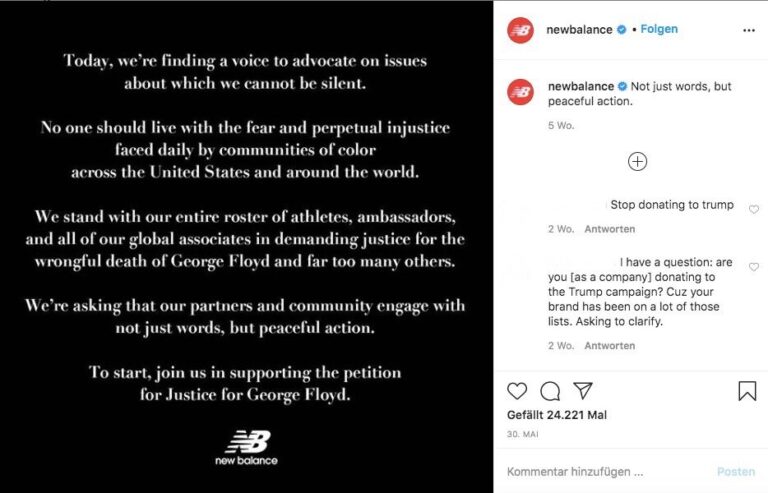
Chiming in during the cries of May 2020, New Balance put out an Instagram post calling for “no words, just peaceful action.” Days after the post, the sports authority committed to donating 10,000 pairs of shoes to Black and Brown communities in Atlanta. What seems like a win, most interpreted as savvy marketing tactics.
Sustainable fashion Matterz calls out that this initiative, while sounding great, does little to advance DEI conversations and rather boosts brand awareness of New Balance in Atlanta, leading to new sales. Aside from being considered a “profitable donation,” the article further noted that New Balance CEO Jim Davis financially supported politicians who gave disputedly racist or incredibly racially charged speeches.
New Balance’s donation, though seemingly earnest, either deliberately or blindly ignored the opportunity to meet the moment with real action to elevate black and brown people and, as a result, did not meet the moment authentically.
As noted, this practice leads to declines in brand sentiment, a social media nightmare, and fewer sales.
To actively avoid engaging in Brownwashing, companies can:
- Engage in discussion about how to unlearn potentially racist behaviors.
- Elevate black and brown voices within your organizations.
- Look inward to understand how company or brand initiatives and investments align with DEI causes for BIPOC individuals.
- Advocate for team members who may not be able to advocate for themselves.
- Listen to black and brown team members to better understand their lived experiences.
Not as light and snappy as we usually are, huh? In some cases, choosing the ethical route involves difficult conversations. As uncomfortable as they may be, we lean into that discomfort to better grasp our responsibility as marketers to do our best to tell our stories. We might not always get it right, but as long as we understand how to be a better version of ourselves daily, we will continue to grow.
As we do so, we must acknowledge our consumers’ rapidly evolving minds. Failure to resonate with them means more than some harsh words on the internet. It jeopardizes the longevity of our business.
It can be challenging, but you’re never alone. Look inward if you wonder if your business is directly or indirectly in color washing. Ask your team; they will tell you. Second, ask your leadership: does this align with our brand, or do we want it to be? That answer will hopefully prompt a difficult but earnest conversation. With that decision in mind, hiring a consultant to work with your team might be wise to get where you want to go. If that’s the case, let us know. We know some people (it’s us, and we’re some people).

